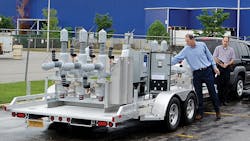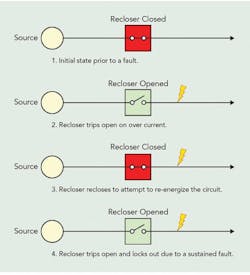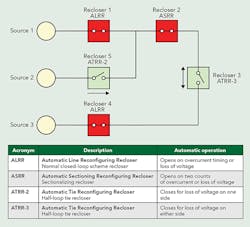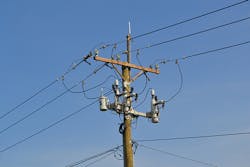In 2011, Commonwealth Edison (ComEd) announced it would be investing US$2.6 billion over 10 years, under the Energy Infrastructure and Modernization Act passed by the Illinois General Assembly, to modernize the power system with digital technology and replace, refurbish and upgrade electric equipment across its territory. The utility is investing $1.3 billion to strengthen the electric system and another $1.3 billion to add digital smart grid and advanced meter technology.
A significant portion of this investment is going toward the development and deployment of automated reclosers to improve reliability and reduce the number of customers affected by outages.
All About the Reclosers
ComEd started installing reclosers at circuit mid-points in 2001 as stand-alone devices. When a fault occurs on the circuit downstream of the recloser, the recloser trips open to clear the fault. The recloser recloses in an attempt to restore power in case the fault is temporary, such as a tree branch falling on a line. If the fault is not cleared, the recloser trips back open and, ultimately, locks out because of the sustained fault. The recloser will remain open until it is manually closed to restore power after the circuit has been repaired.
With a high volume of faults upstream of the mid-point reclosers, in 2004, ComEd started installing tie reclosers at normally open tie points on the circuits. Voltage sensing was added to the normally open and normally closed reclosers, creating loop-scheme functionality with the ability to restore the back section of the circuit for a front section fault. Loop-scheme reclosers do not communicate with each other, but they have the ability to communicate to the supervisory control and data acquisition (SCADA) system.
All intelligence is local, based on seeing an overcurrent or a voltage loss. As a result, normally open reclosers may close into a de-energized fault previously isolated by another recloser as they do not know why voltage was lost. To minimize fault exposure, the tie reclosers immediately clear the fault and lock out.
To break up the circuits into smaller segments, reducing customer exposure when a fault occurs, more complex loop schemes were installed with reclosers in series and multiple tie reclosers. For a fault between two normally closed reclosers, the upstream recloser locks open to isolate the fault; the downstream recloser then senses a loss of voltage and opens. The tie reclosers in each section sense a loss of voltage and close to restore power to each section between the reclosers. The tie between the upstream normal closed recloser and the downstream normal closed recloser closes and trips back open. The tie past the downstream normal closed reclosers closes and holds to restore that section of line. The reconfiguration is complete in about a minute.
As new technology is developed and more enhancements are available from different vendors, utilities face the difficulty of incorporating varying distribution automation equipment onto their systems. One example of an enhancement is separating the recloser into separate modules with integral voltage sensors to allow for voltage measurement on both the line and load sides of the device without the need for external sensing and cabling. These modules can trip and operate the phases independently, allowing the recloser to be set to trip or lock out on a single phase or on all three phases, as compared to a traditional three-phase recloser.
Bringing new distribution automation equipment onto the utility system involves significant planning to ensure the new technology will fit into existing schemes:
• Developing settings
• Testing the equipment
• Training the various work groups involved with the equipment, from the initial design process through construction and operation of the equipment.
Distribution Automation Pilot Project
At the end of 2011, to prepare for the Energy Infrastructure and Modernization Act passed by the Illinois General Assembly, ComEd initiated a pilot project to evaluate the addition of a newer generation of loop-scheme reclosers to its installed base of approximately 1,600 12-kV reclosers. For the pilot, ComEd chose G&W Electric’s Viper-ST reclosers fitted with SEL-651R1 recloser controls. The pilot consisted of seven reclosers installed in three different schemes across the utility, including a mixed scheme with existing reclosers.
The first step was to build a construction standard of the recloser and identify the hardware requirements of the recloser. The utility decided on a site-ready model with arresters, potential transformers for power and wiring pre-installed. Crossarm and alley arm options were designed to allow for installation across the system.
Once the three specific schemes for the pilot were identified and a construction specification was developed, engineering created a design package for each of the jobs.
In a parallel effort, the process to develop the settings began by listing the operational requirements based on matching the operation of existing loop-scheme reclosers on the system. For example, the timing requirements for a loop scheme and the response to an under-frequency condition were included. ComEd uses standard settings files for the reclosers based on the function of the recloser (for example, a normally open loop scheme and a normally closed loop scheme) with the only differences from device to device being site-specific changes such as communication settings and sensor settings, resulting in eight base settings files.
Once the requirements were established, potential enhancements to the scheme were reviewed to determine if they should be added to the settings specifications. For the enhancements mentioned previously, ComEd decided to set the reclosers to single-phase trip, three-phase lockout.
New operating procedures were developed specific to the new reclosers. SCADA point lists were developed after settings were tested and modeled after the points list of the existing reclosers on the system. Mapping symbols of the reclosers also were updated along with the SCADA build.
Testing the Systems
ComEd and the vendor worked together to test the new systems, beginning with secondary control testing. This involved low-current, low-voltage testing with a single control and testing the logic settings against the specification. The latter included testing of the customized display logic, fault detection and loss of voltage functions. Testing began manually, using a test set. This was followed by automatic testing for easily repeatable tests in many combinations. The communications testing consisted of benchtop testing using a SCADA master simulator and then moving on to ComEd’s radios in its lab. Full SCADA field tests were performed on each of the pilot installations along with the first installations of the systemwide deployment.
Primary system testing was performed as factory acceptance testing was done twice, using different fault scenarios and, where necessary, jumper cables to replicate non-normal topologies. Testing was done at high current and low voltage with multiple controls and reclosers. Test system coordination and behavior were checked, user-driven test scenarios were run and witness testing was performed.
Testing was done with ComEd standard settings and custom logic, defined as logic added to factory defaults or pretested points of departure. All new functionality had to be rigorously tested. Once the logic was confirmed, the settings were tested.
The Need for Training
ComEd has been updating its distribution automation gradually for several decades and, in consequence, has a variety of equipment of varying ages. With this diversity in equipment, all work groups involved in various stages of the equipment must be trained on the reclosers.
To meet the training challenge, ComEd worked with the vendor to develop different training modules targeted for each work group, such as dispatchers, construction crews, field operating crews, distribution testing technicians and engineering. The most comprehensive was the distribution testing training to prepare detailed information for the field technicians on the operation of the equipment, how to configure and commission the devices, and how to troubleshoot the equipment.
Several of the groups were sent to the vendor’s factory to do hands-on training. In addition, a trailer outfitted with a recloser and control was transported to crews for training in the field using the training modules created. This allowed the crews hands-on training prior to working on installed equipment.
Quick-reference guides also were developed and distributed as part of the training to highlight the operation of the new equipment as well as the differences between the existing and new equipment.
From Pilot to Deployment
The pilot was rapidly followed by a systemwide deployment in 2013, which involved installing more than 400 of the new reclosers. While the pilot was running, ComEd’s corporate parent, Exelon, had developed a standard that called for standardization of the control faceplate, requiring modifications to the pilot settings and training material. At the same time, a new generation of control was issued by the vendor. The new faceplate and control, combined with lessons learned from the pilot, required revisiting all the settings developed and updating the settings specifications, as well as updating each of the training modules developed during the pilot.
Because changes to the custom logic were made from the pilot settings, full testing was performed again on the settings issued for the systemwide deployment.
Results of the Deployment
ComEd has installed more than 3,000 distribution automation reclosers on the 12-kV system and 1,000 switches on the 34-kV system since the mid-1990s. In 2011, approximately 1.1 million customer interruptions were avoided, in addition to 1.1 million in 2012 and 0.94 million in 2013. An estimated 1.3 million customers will have avoided interruptions in 2014, approximately a 22% increase over the prior three-year average, because of the additional recloser installations.
Lessons Learned
ComEd and the vendor reviewed the pilot and systemwide deployment to identify lessons learned. Rigorous testing of the settings and behavior of the recloser were identified as crucial. These, along with thorough training materials, were among the top lessons identified. The difficulty remains in balancing improvements in new technology with operating a hybrid system of distribution automation devices with differing functionality. Each operation involving the new reclosers is analyzed to confirm proper operation and evaluate improvements. Also, with new equipment, as issues arise, it is important to share troubleshooting methods and results to build expertise in the equipment.
Acknowledgements
The authors would like to express appreciation to Erich Keller, automation engineer, distribution automation, and Karla Trost, product manager, switchgear automation, at G&W Electric Co., as well as John Madden at Midwest Electrical for their significant contributions throughout this project.
Marina Mondello ([email protected]) is a senior engineer in the reliability programs department at Commonwealth Edison and was formerly in the distribution automation group, which monitors and troubleshoots the utility’s distribution automation system and develops settings for distribution automation equipment. Mondello has been with ComEd for 14 years in the distribution testing and new business departments. Mondella holds a BSEE degree from Rose-Hulman Institute of Technology.
Anil Dhawan ([email protected]) is a senior engineer in the distribution standards and technical support department at Commonwealth Edison. He serves as the technical subject-matter expert supporting equipment design and standards, failure analysis, and construction and maintenance activities for distribution- and automation-related equipment. Dhawan has been with ComEd for more than 22 years, providing support and technical expertise in various substation- and distribution-related positions. He holds a BSEE degree and is a member of IEEE.
Renu Gupta ([email protected]) is a senior engineer technical specialist in the reliability analysis group at Commonwealth Edison. Gupta has been with the utility since 1999. Gupta holds a bachelor’s degree in computer engineering and is an Oracle certified professional.
Mentioned in this article:
Commonwealth Edison | www.comed.com
G&W Electric | www.gwelec.com




